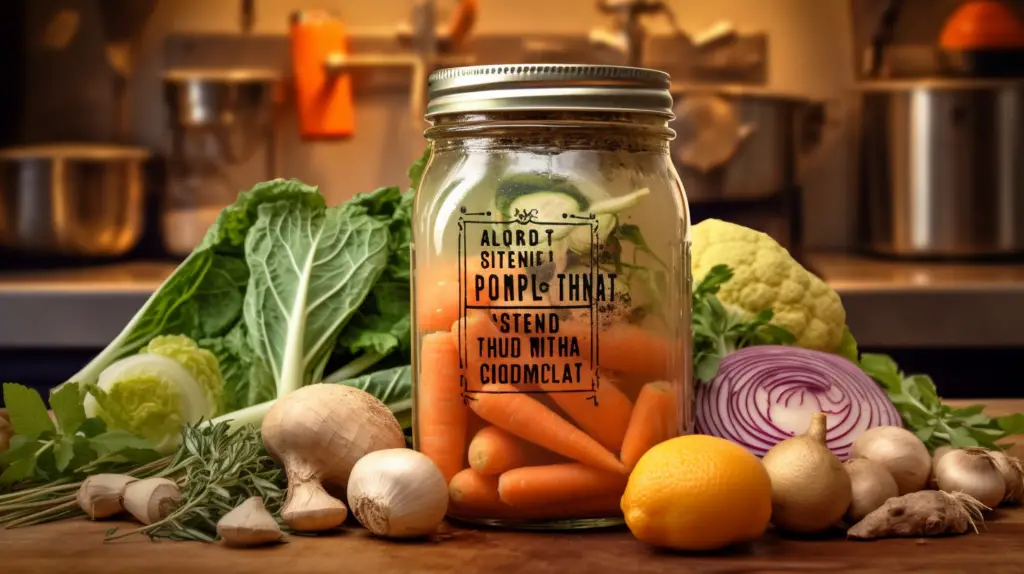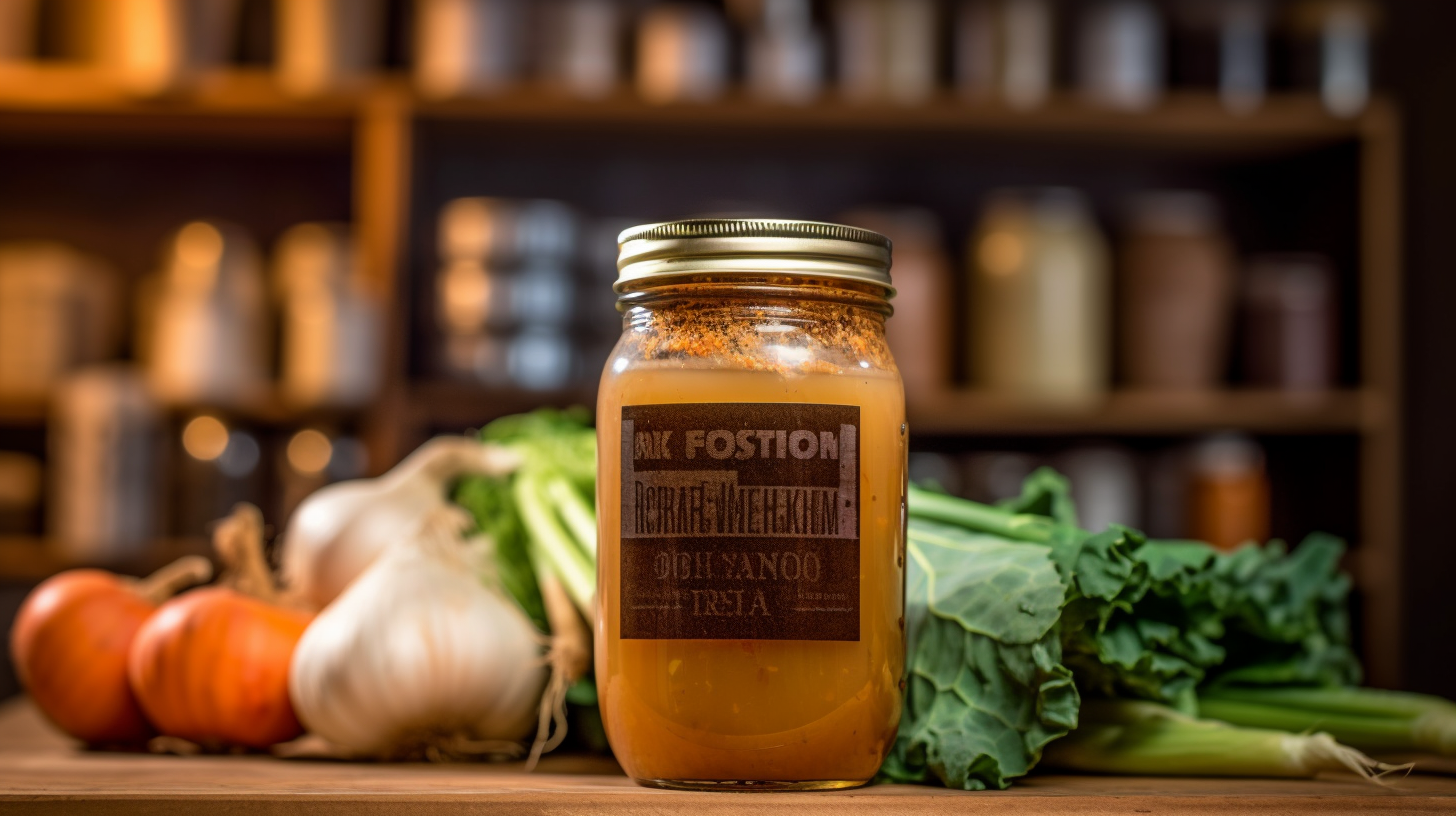Vegetable broth is a popular ingredient in many cuisines, especially for those who prefer vegetarian or vegan diets. It is commonly used as a base for soups, stews, and sauces to add flavor and nutrients to the dishes. However, like any other food product, vegetable broth does not last forever and can eventually spoil. Understanding its shelf life is crucial to avoid consuming spoiled broth that may cause health problems.
In this article, we will explore the factors that affect the longevity of vegetable broth and how to properly store it in the fridge or freezer to extend its shelf life. We will also discuss the signs of spoiled or expired vegetable broth and provide tips on how to use up leftover vegetable broth.
Additionally, we will offer some insights into making fresh vegetable broth at home so that you can enjoy its benefits without worrying about its expiration date.
Key Takeaways
- Vegetable broth has a limited shelf life and can spoil, but proper storage can extend its shelf life.
- Frozen vegetable broth can last up to six months without losing flavor or nutrients, while pressure canning can extend its shelf life up to one year.
- Homemade or store-bought veggie broths need refrigeration within two hours of preparation or opening and must be consumed within four days.
- Storing vegetable broth in an airtight container in the fridge can help prevent contamination and extend its shelf life.
Understanding the Shelf Life of Vegetable Broth

The assessment of the shelf life of vegetable broth is a crucial consideration for ensuring food safety and minimizing food waste. Vegetable broth, like any other perishable product, has a limited storage duration before it goes bad. The good news is that there are ways to extend the shelf life of vegetable broth without compromising its quality and flavor.
One way to prolong the longevity of vegetable broth is by storing it in an airtight container and refrigerating it immediately after use. Refrigeration slows down bacterial growth, which can cause spoilage. Another option is freezing the broth in portioned containers or ice cube trays for easy use later on. Frozen vegetable broth can last up to six months without losing its flavor or nutritional value.
It’s worth mentioning that different types of vegetables can be used to make varied flavors of vegetable broth, making it a versatile ingredient in many dishes. Some popular variations include mushroom broth, tomato-based broths, and root vegetables’ stocks such as beetroot and carrot. These variations offer endless possibilities when preparing different kinds of meals.
Understanding how to store vegetable broth correctly and exploring various flavor options can help prolong its shelf life while enhancing your culinary experience. However, several factors affect the longevity of veggie stock beyond proper storage techniques or added ingredients.
Factors That Affect the Longevity of Vegetable Broth

Various factors such as the freshness of ingredients, storage temperature, and exposure to air can impact the shelf life of vegetable broth, much like how sunlight affects the color of a painting over time.
Freezing methods play a substantial role in preserving vegetable broth for extended periods. When properly stored in an airtight container or freezer bag and placed in the coldest part of the freezer, vegetable broth can last up to six months without losing its flavor or nutritional value.
Another effective preservation technique is pressure canning. This method involves packing hot liquid into jars and processing them at high temperatures for a specific duration to ensure that all bacteria are eliminated. Properly canned vegetable broth can last up to one year if stored in cool, dry conditions.
While there are several ways to preserve vegetable broth, storing it in the fridge might not be the most efficient option due to its relatively short shelf life. Typically, homemade or store-bought veggie broths need refrigeration within two hours of preparation or opening and must be consumed within four days.
Therefore, it’s crucial to make only what you’ll use promptly and avoid buying more than you need.
Various factors influence how long vegetable broth lasts before spoiling; however, proper freezing methods and pressure canning techniques are some effective ways to extend its shelf life significantly.
Nevertheless, when it comes down to storing leftovers in your fridge, it’s best always to err on the side of caution by consuming them within four days at most.
Storing Vegetable Broth in the Fridge
Proper storage of homemade or store-bought vegetable broth in the fridge is essential to maintain its quality and prevent spoilage. To maximize freshness, it is crucial to cool the broth immediately after cooking or opening the package. The temperature of the fridge should be set at 40°F or below to ensure that the broth stays safe for consumption.
Storing vegetable broth in an airtight container can help prevent contamination from other foods and odors in the fridge. If you have leftovers, it’s best to repurpose them within four days as the broth can start losing its flavor after that time frame. Additionally, always make sure to check for any signs of spoilage before consuming leftover broth.
While storing vegetable broth in the fridge can extend its shelf life by several days, freezing it can further prolong its longevity. In our next section, we will discuss how freezing vegetable broth works and what precautions you need to take when doing so.
Note: It’s important to remember that these guidelines are not absolute and may vary depending on various factors such as pH level, storage conditions, type of vegetables used in making the broth, etc. Always use your judgment and common sense when deciding whether a particular batch of vegetable broth is still safe for consumption.
Freezing Vegetable Broth for Extended Shelf Life
Freezing homemade or store-bought vegetable broth can extend its shelf life significantly, with studies showing that frozen broth can remain safe for consumption for up to six months. Freezing is a simple and effective way of preserving excess vegetable broth. Using ice cube trays is an excellent method of freezing broth, as it allows you to portion the broth into small cubes that can be easily thawed when needed. This technique also enables you to use only what you need, reducing food waste.
In addition to using ice cube trays, creative recipes for frozen broth are available online. For example, freezing vegetable broth in silicone molds shaped like hearts or stars adds a fun twist to your dishes and makes them more visually appealing. Another alternative is freezing the broth in plastic bags laid flat on a sheet pan. Once frozen, these bags can be stacked flat in the freezer, saving valuable space.
While freezing vegetable broth is an excellent preservation method, alternatives exist for those who prefer not to freeze their excess broth. One such option is pressure canning; this process involves heating the jars of vegetable stock in a pressure cooker under high heat until they reach a temperature that destroys any harmful bacteria present in the liquid.
Freezing vegetable broth remains one of the most popular methods used by many households to preserve their excess stock safely. However, there are alternatives such as pressure canning if preferred over freezing. In addition to using ice cube trays and unique shapes for convenience and aesthetics purposes when storing frozen veggie stocks saves space while making your dishes look great! In the next section about signs of spoiled or expired vegetable broths will highlight some key indicators that it’s time to discard your stock before consuming it further without risking any health implications from eating contaminated foods.
Signs of Spoiled or Expired Vegetable Broth
Detecting signs of spoiled or expired vegetable broth involves observing changes in its appearance, smell, and taste. It is important to check the broth before using it in any recipe to avoid foodborne illnesses. Here are 4 signs that your vegetable broth has gone bad:
- Off Flavors: If you notice a sour or bitter taste in the broth, it means that the lactic acid bacteria have started growing on it. The off-flavor is a clear indication of spoilage and should be discarded immediately.
- Discoloration: Signs of expired vegetable broth may include color changes such as darkening or cloudiness. The presence of mold indicates that bacteria have infiltrated the liquid and can cause health problems when consumed.
- Strange Smell: A strong unpleasant odor is another indicator that your vegetable broth has gone bad. If you detect an unusual smell like musty or rancid odors, discard it entirely.
- Bloating container: If there’s air trapped inside the container lid after opening, there’s fermentation happening inside which leads to bloating and musty smells – both of these indicate spoilage.
Consuming spoiled vegetable broth can be harmful to one’s health; therefore, one needs to keep track of expiration dates while storing them properly in refrigerators or freezers for longevity purposes.
Tips for using up leftover vegetable broths creatively will be discussed in subsequent paragraphs without wasting anything from your kitchen pantry!
Using Up Leftover Vegetable Broth
After learning about the signs of spoiled or expired vegetable broth, it’s important to consider what can be done with leftover broth. Instead of throwing it away, one option is to use it in creative recipes and reduce food waste.
Vegetable broth can add flavor and depth to a variety of dishes such as soups, stews, risottos, and even sauces. One delicious way to use up leftover vegetable broth is by making a hearty vegetable soup. Simply sauté onions and garlic in a pot, add vegetables like carrots, celery, and potatoes along with the leftover broth and let everything simmer until the vegetables are tender. You can also get creative by adding beans or lentils for extra protein or pasta for some texture.
Another idea is to use the broth as a base for a flavorful sauce. Add herbs like thyme and oregano along with some tomato paste for an Italian-inspired sauce that pairs well with pasta. Alternatively, mix in some peanut butter and soy sauce for an Asian-inspired peanut sauce that goes great on stir-fry dishes.
By using up leftover vegetable broth instead of throwing it away, you’re not only reducing food waste but also getting more bang for your buck.
Now that we’ve explored some ideas on how to use up leftover broth let’s move on to tips for making fresh vegetable broth at home without any wastage of ingredients.
Transition: Now that we have covered all there is about using up leftovers efficiently let’s dive into how you can make fresh vegetable stock at home without wasting any ingredients.
Tips for Making Fresh Vegetable Broth at Home
To create a flavorful and nutritious homemade vegetable stock, one can follow these tips that are as essential as soil is to plants.
First, it is important to use fresh vegetables and herbs. Vegetables that are past their prime or starting to wilt will not produce a good broth. Additionally, using a variety of vegetables will add depth of flavor to the broth. Some suggestions include carrots, onions, celery, garlic, mushrooms, and herbs such as thyme and parsley.
Secondly, roasting the vegetables before simmering them in water can enhance the flavor of the broth by caramelizing their natural sugars. To do this, chop the vegetables into small pieces and roast them at 400°F for about 30 minutes until they start to brown around the edges. Then add them to a large pot with water and let simmer for several hours.
Thirdly, adding some acidity can help break down the vegetables and release more flavor into the broth. This can be achieved by adding a splash of apple cider vinegar or lemon juice during cooking.
Lastly, straining out any solids after simmering will result in a clear and smooth vegetable broth. Use a fine mesh strainer or cheesecloth to remove any bits of vegetable from the liquid.
Variations on vegetable broth recipes are endless depending on personal preferences and availability of ingredients. One could add tomatoes for richness or chili peppers for spice.
Benefits of homemade vegetable broths include being low in calories while providing an abundance of vitamins and minerals due to its high concentration of veggies used in making it – nutrients including magnesium (which is important for healthy bones), potassium (which helps regulate blood pressure), folate (essential for brain function) among others depending on what was used in your recipe! Homemade broths also don’t have any additives like MSG which you often find in store-bought versions enjoyed by many people who want control over what goes into their food intake without sacrificing taste!
Making homemade vegetable broth is not only easy and cost-effective, but it also allows for customization to personal preferences. By using fresh vegetables and herbs, roasting them before simmering, adding acidity, and straining out solids, one can create a flavorful and nutritious broth. The versatility of vegetable broths means that there are endless variations to try as well as many health benefits to enjoy.
Frequently Asked Questions
Can vegetable broth be used as a substitute for chicken or beef broth in recipes?
Vegetable broth can indeed be used as a substitute for chicken or beef broth in recipes, but it’s important to note that vegetable broth has a distinct flavor profile compared to meat broths.
Vegetable broths are typically lighter and have a more herbaceous taste due to the absence of meat-derived flavors. This makes them particularly suitable for vegetarian or vegan dishes where the focus is on showcasing the natural flavors of vegetables.
However, if you’re looking for a richer, heartier flavor in your dish that comes from using meat broth, then vegetable broth may not be the best substitute. Ultimately, it depends on personal preference and the specific recipe being made.
How does homemade vegetable broth differ from store-bought broth?
According to a study published in the Journal of Food Science, homemade vegetable broth has significantly higher levels of antioxidants and phenolic compounds compared to store-bought varieties. These compounds have been linked to potential health benefits such as reducing inflammation and lowering the risk of chronic diseases.
In terms of flavor differences, homemade broth allows for more customization in terms of adding spices and herbs for a personalized taste. Store-bought broths often contain added salt and preservatives which can affect the overall flavor profile.
While both options may serve as suitable substitutes for chicken or beef broth in recipes, homemade vegetable broth offers nutritional advantages and the ability to tailor flavors to individual preferences.
Is it safe to consume vegetable broth past its expiration date?
To answer the current question of whether it is safe to consume vegetable broth past its expiration date, it is important to consider food safety and storage options.
Generally speaking, consuming expired food products can pose a risk to one’s health as it may contain harmful bacteria that can cause foodborne illnesses.
However, the shelf life of vegetable broth varies depending on several factors such as the ingredients used, processing method, and storage conditions.
It is recommended to follow the manufacturer’s guidelines for proper storage and use-by dates.
If stored properly in an airtight container in the refrigerator or freezer, homemade or store-bought vegetable broth can last up to 4-5 days or even up to 6 months respectively.
Nevertheless, if there are any signs of spoilage such as off odor or appearance changes then it is best not to consume it beyond its expiration date.
Can vegetable broth be used as a base for soups and stews?
Using vegetable broth as a base for soups and stews is a popular choice among vegans and vegetarians. The richness of the flavor adds depth to any dish, making it a versatile ingredient in the kitchen. It can be used in place of water to add extra taste, or simply enjoyed on its own as a warm beverage.
When preparing vegan or vegetarian dishes, using vegetable broth helps to create a more complex flavor profile that can satisfy even the most discerning palates. While it’s important to keep in mind how long vegetable broth lasts before consuming it past its expiration date, incorporating it into dishes is an excellent way to elevate any recipe and enhance the overall dining experience.
What are some creative ways to use leftover vegetable broth in cooking?
When searching for creative ways to use leftover vegetable broth in cooking, there are plenty of options available. Recipes using vegetable broth leftovers can include everything from risottos and pasta dishes to soups and stews.
One particularly popular technique is to use the broth as a base for a flavorful sauce or gravy, which can be used to enhance the flavor of a variety of different meals. Additionally, there are many ways to enhance vegetable broth flavor by adding spices, herbs, or even citrus fruits like lemon or lime.
By experimenting with different ingredients and techniques, you can find endless possibilities for incorporating leftover vegetable broth into your cooking repertoire.
Conclusion
In conclusion, the shelf life of vegetable broth varies depending on several factors like storage temperature, container type, and processing method. Proper storage of vegetable broth in airtight containers in the fridge can extend its lifespan up to 4-5 days. Freezing vegetable broth is also a viable option for longer-term storage as it can last up to 3 months.
It’s essential to monitor signs of spoilage or expiration like off-smell, mold growth or cloudiness before consuming leftover vegetable broth. Lastly, homemade vegetable broth provides an excellent alternative to store-bought ones as it ensures quality control and customization of ingredients.
As the saying goes, ‘you are what you eat,’so investing time and effort into making healthy homemade food choices can significantly impact one’s well-being.

